
According to the results of a survey conducted by Active Group and Experts Club, most Ukrainians refrain from actively evaluating Uruguay. 71% of respondents described their attitude as neutral, while another 12.1% were unable to decide.
However, 12.4% of respondents expressed a positive attitude (9.2% mostly positive, 3.2% completely positive). Only 4.4% expressed a negative attitude (3.7% mostly negative, 0.7% completely negative).
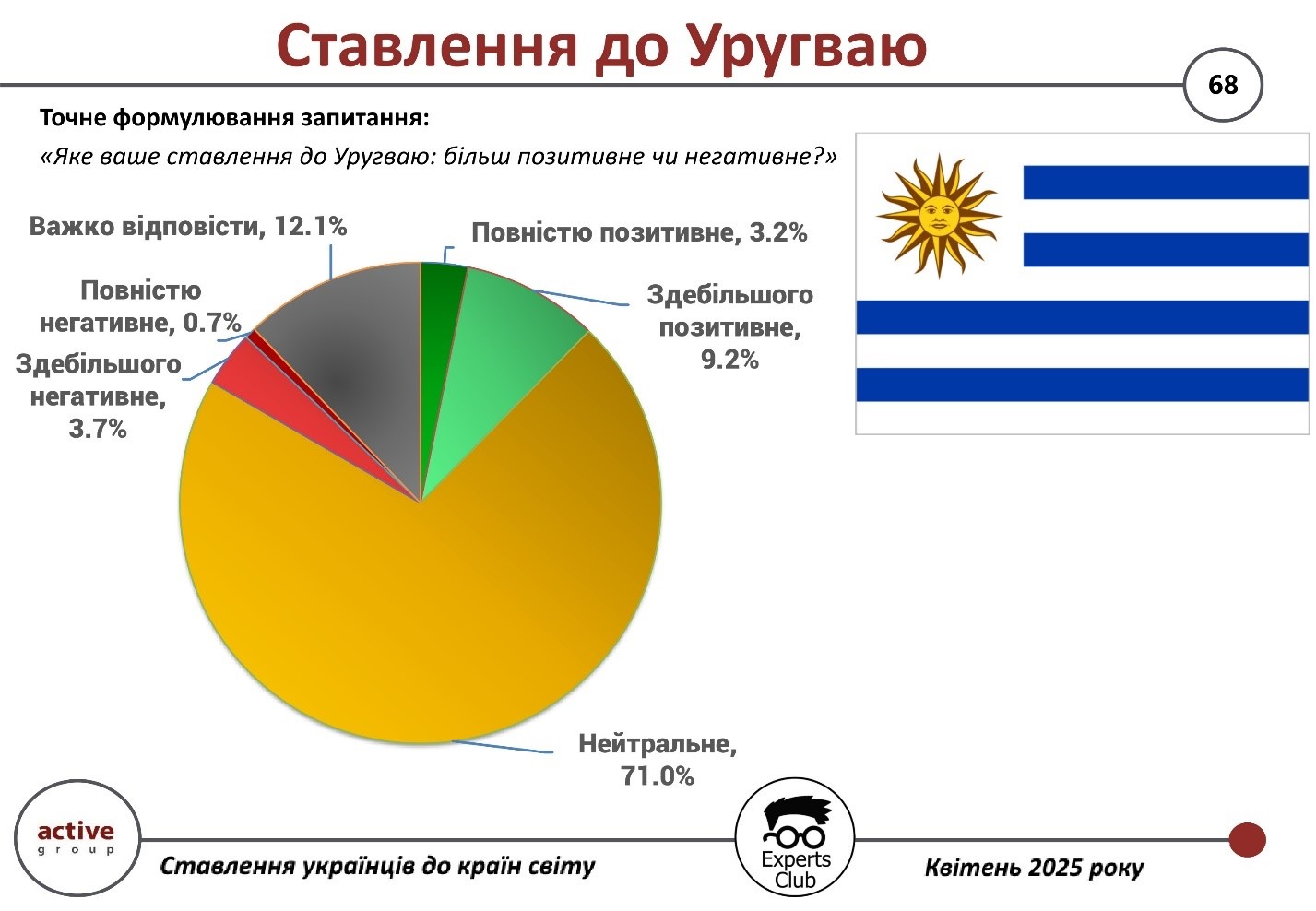
“The positive attitude towards Uruguay is linked to its stable democratic image in Latin America. However, the country remains largely unknown to most Ukrainians, which explains the high level of neutrality,” comments Maksim Urakin, PhD in Economics and founder of the Experts Club information and analytical center.
Uruguay is perceived by Ukrainians as neutral or moderately positive. The indicators show a lack of stereotypes, but also a low level of awareness about the country.
The presentation of the study is available at the link.
ACTIVE GROUP, DIPLOMACY, EXPERTS CLUB, Pozniy, SOCIOLOGY, URAKIN

A survey conducted by Active Group in collaboration with the Experts Club think tank showed that most Ukrainians have a neutral attitude toward Laos — 70.7% of respondents chose this option.
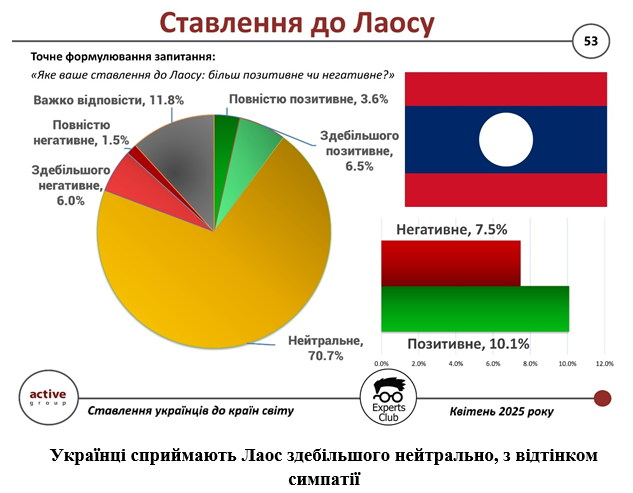
A positive attitude was expressed by 10.1% of respondents, of whom 6.5% answered “mostly positive” and another 3.6% “completely positive.” At the same time, 7.5% of respondents expressed a negative opinion — of these, 6.0% chose “mostly negative” and 1.5% “completely negative.” The option “difficult to answer” was chosen by 11.8% of respondents.
According to Pozniy, these results can be explained by the low level of information about Laos in the Ukrainian media.
“For most Ukrainians, Laos is an exotic, little-known country, so a neutral attitude prevails. But against the backdrop of general neutrality, sympathy can also be seen — more than 10% of positive responses,” said Oleksandr Pozniy, co-founder of Active Group.
More than two-thirds of Ukrainians have a neutral attitude toward Laos, which indicates a limited understanding of the country. The positive share corresponds to the average level for lesser-known Asian countries, and the high percentage of those who are undecided indicates potential for cultural rapprochement and information education.
The presentation of the study is available at the link.
ACTIVE GROUP, DIPLOMACY, EXPERTS CLUB, Pozniy, SOCIOLOGY, URAKIN

According to the results of a sociological survey conducted by Active Group and the Experts Club analytical center, Ukrainians’ attitude towards Cambodia is mostly neutral — 71% of respondents chose this option.
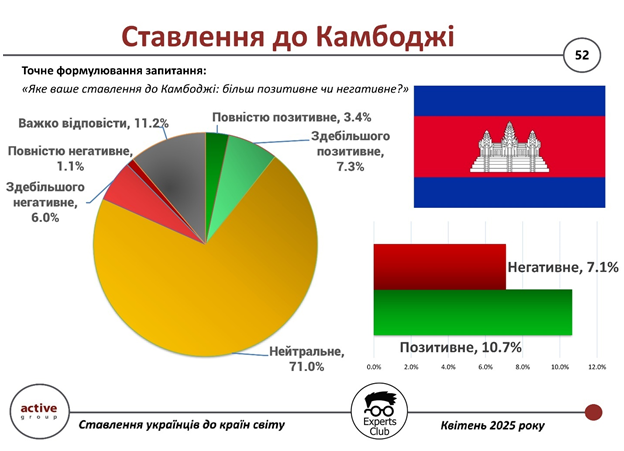
A total of 10.7% of respondents have a positive attitude toward Cambodia: 7.3% of them are mostly positive, and 3.4% are completely positive. On the other hand, 7.1% of Ukrainians have a negative attitude, including 6% who are mostly negative and 1.1% who are completely negative. Another 11.2% were unable to determine their attitude.
“Such a high percentage of neutrality indicates that there is no stable image of Cambodia in the mass consciousness of Ukrainians. It is a country that is rarely mentioned in the context of political or economic news, so the emotional background regarding it is minimal,” explains Maksim Urakin, candidate of economic sciences and founder of the Experts Club information and analytical center.
Ukrainians generally do not have a clear idea about Cambodia, which leads to a high level of neutrality. Positive perceptions exist but are not dominant, which opens up opportunities for the development of cultural diplomacy, intergovernmental contacts, and tourism.
The presentation of the study is available at the link.
ACTIVE GROUP, DIPLOMACY, EXPERTS CLUB, Pozniy, SOCIOLOGY, URAKIN

The results of a sociological survey conducted by Active Group in collaboration with Experts Club show that most Ukrainians do not have a formed opinion about Peru.
Thus, 70.3% of respondents chose a neutral position, while another 9.0% were unable to answer. Such a high level of neutrality indicates limited knowledge about the country among the general public.
At the same time, 15.5% of Ukrainians demonstrated a positive attitude (of which 12.1% were mostly positive and 3.4% were completely positive). A negative attitude was expressed by 5.2% (mostly moderately negative).
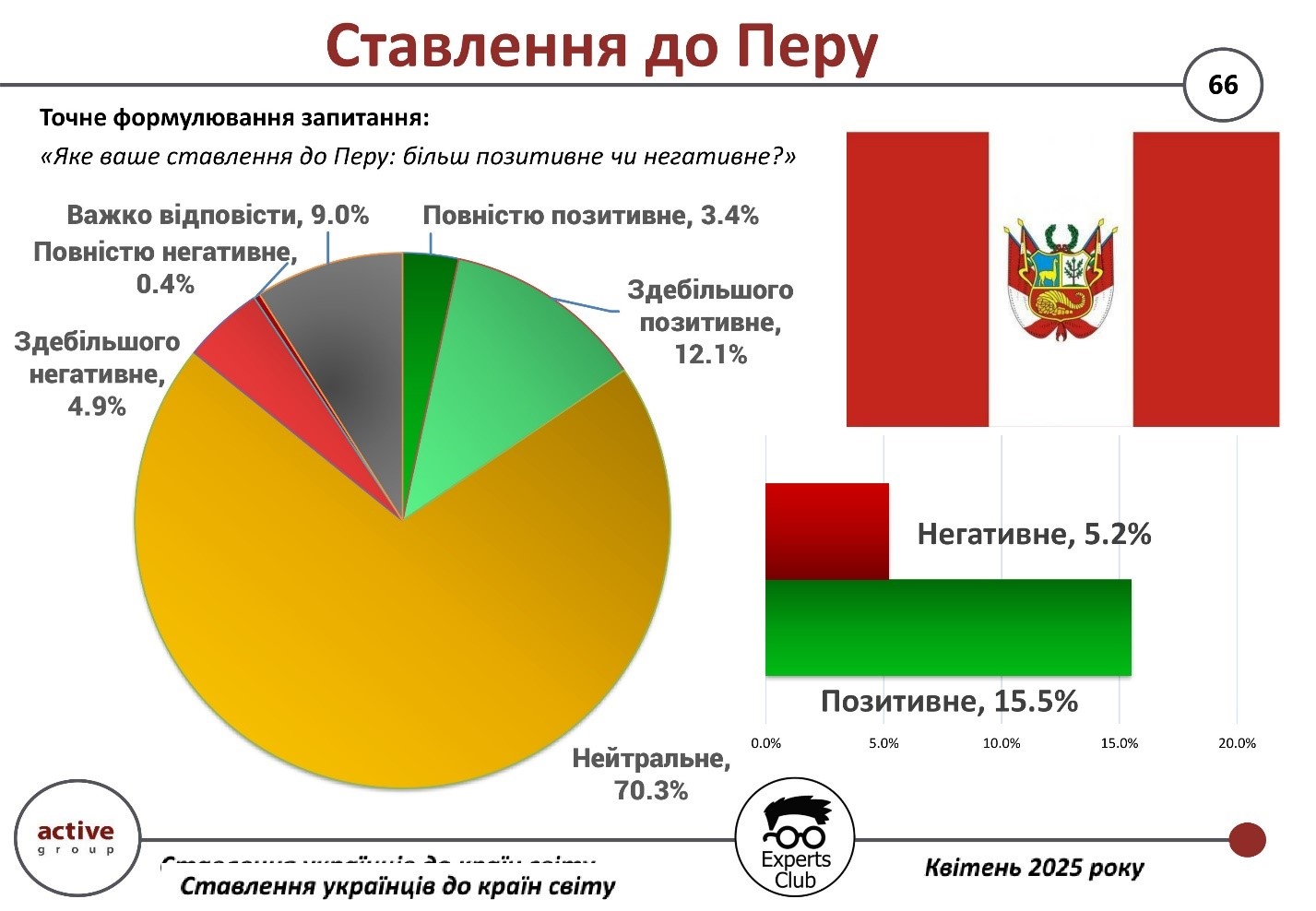
“Peru is associated with exoticism, Inca heritage, and Machu Picchu, but it is not an active player in the Ukrainian information space. Because of this, it arouses curiosity but not strong emotions,” notes Maksim Urakin, candidate of economic sciences and founder of the Experts Club information and analytical center.
Most Ukrainians have a neutral attitude toward Peru, but the proportion of those who like it exceeds the proportion of those who are critical. This creates a basis for potential improvement in intergovernmental contacts in the future.
The presentation of the study is available at the link.
ACTIVE GROUP, DIPLOMACY, EXPERTS CLUB, Pozniy, SOCIOLOGY, URAKIN

The results of a sociological survey conducted by Active Group in collaboration with Experts Club show that Ukrainians’ attitude toward Paraguay is mostly neutral or uncertain.
According to the study, 73.5% of respondents hold a neutral position, while another 10.3% were unable to give a clear answer. Together, this accounts for over 83% of those surveyed, indicating an almost complete lack of knowledge about the country.
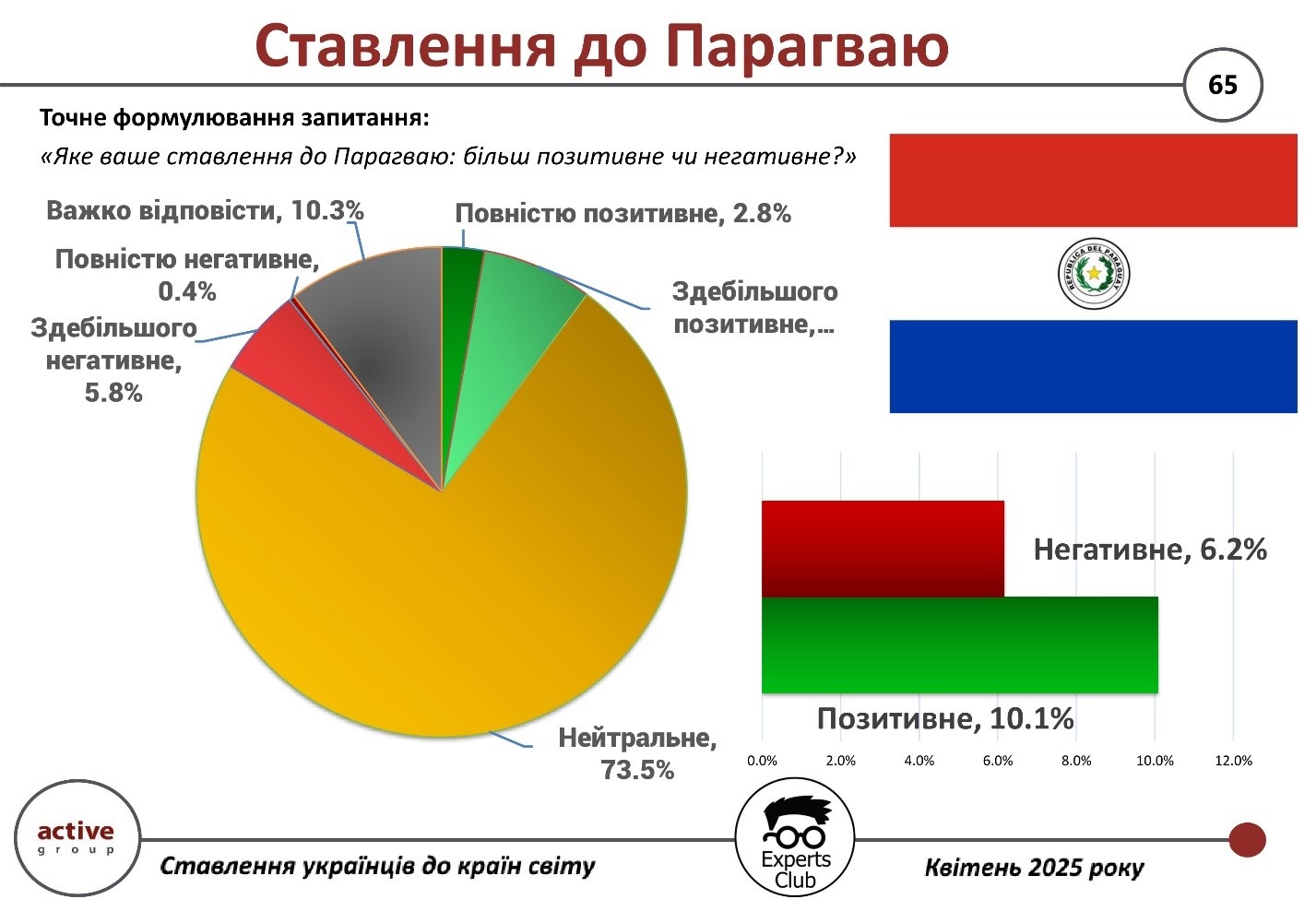
Only 10.1% of Ukrainians have a positive attitude toward Paraguay, of which 7.3% chose “mostly positive” and 2.8% “completely positive.” A negative attitude is held by 6.2% — 5.8% “mostly negative” and 0.4% “completely negative.”
“Paraguay is a country that is rarely mentioned in the news or public discourse. As a result, most Ukrainians have no emotional or informational connection to it,” explains Maksim Urakin, candidate of economic sciences and founder of the Experts Club information and analytical center.
Ukrainians know almost nothing about Paraguay. This attitude is the result of an information vacuum, not established prejudices or sympathies.
The presentation of the study is available at the link.
ACTIVE GROUP, DIPLOMACY, EXPERTS CLUB, Pozniy, SOCIOLOGY, URAKIN

According to a survey conducted by Active Group in collaboration with the information and analytical center Experts Club, Ukrainians’ attitudes toward Colombia remain mostly neutral or negative.
According to the results, 57.4% of respondents hold a neutral position, while 19.1% expressed a negative attitude. Of these, 18.1% said their attitude was “mostly negative” and another 0.9% said it was “completely negative.”
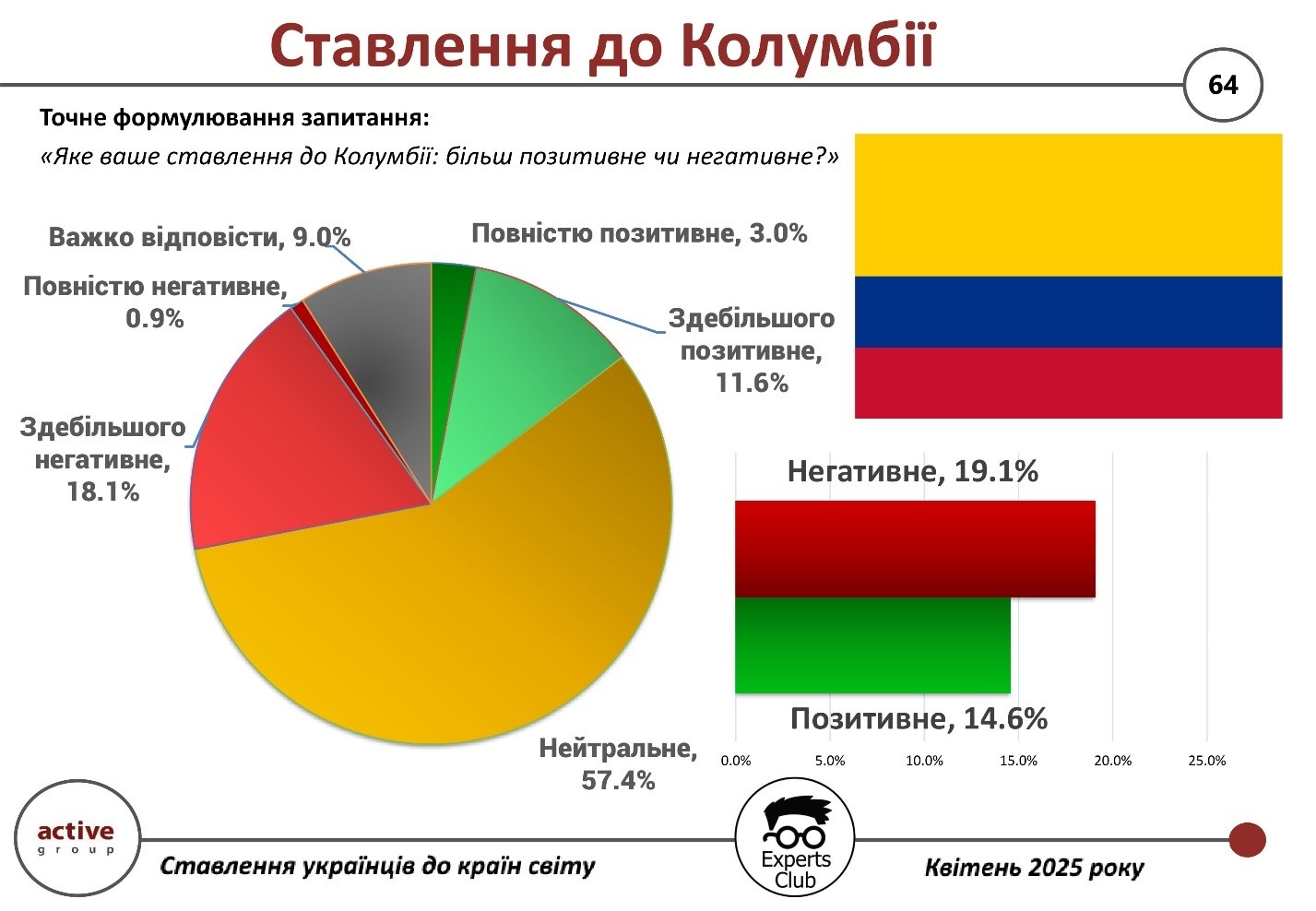
A positive attitude is held by 14.6% of Ukrainians — 11.6% chose “mostly positive” and 3% “completely positive.” Nine percent of respondents were unable to decide on an answer.
“The image of Colombia in popular culture as a country with high crime rates, drug cartels, and political instability influences perceptions. Even with minimal news coverage, this associative framework remains,” comments Maxim Urakin, candidate of economic sciences and founder of the Experts Club information and analytical center.
Colombia has one of the highest levels of negative perception among Latin American countries. This demonstrates the power of stereotypes in shaping public opinion, even with a small amount of relevant information.
The presentation of the study is available at the link.
ACTIVE GROUP, DIPLOMACY, EXPERTS CLUB, Pozniy, SOCIOLOGY, URAKIN